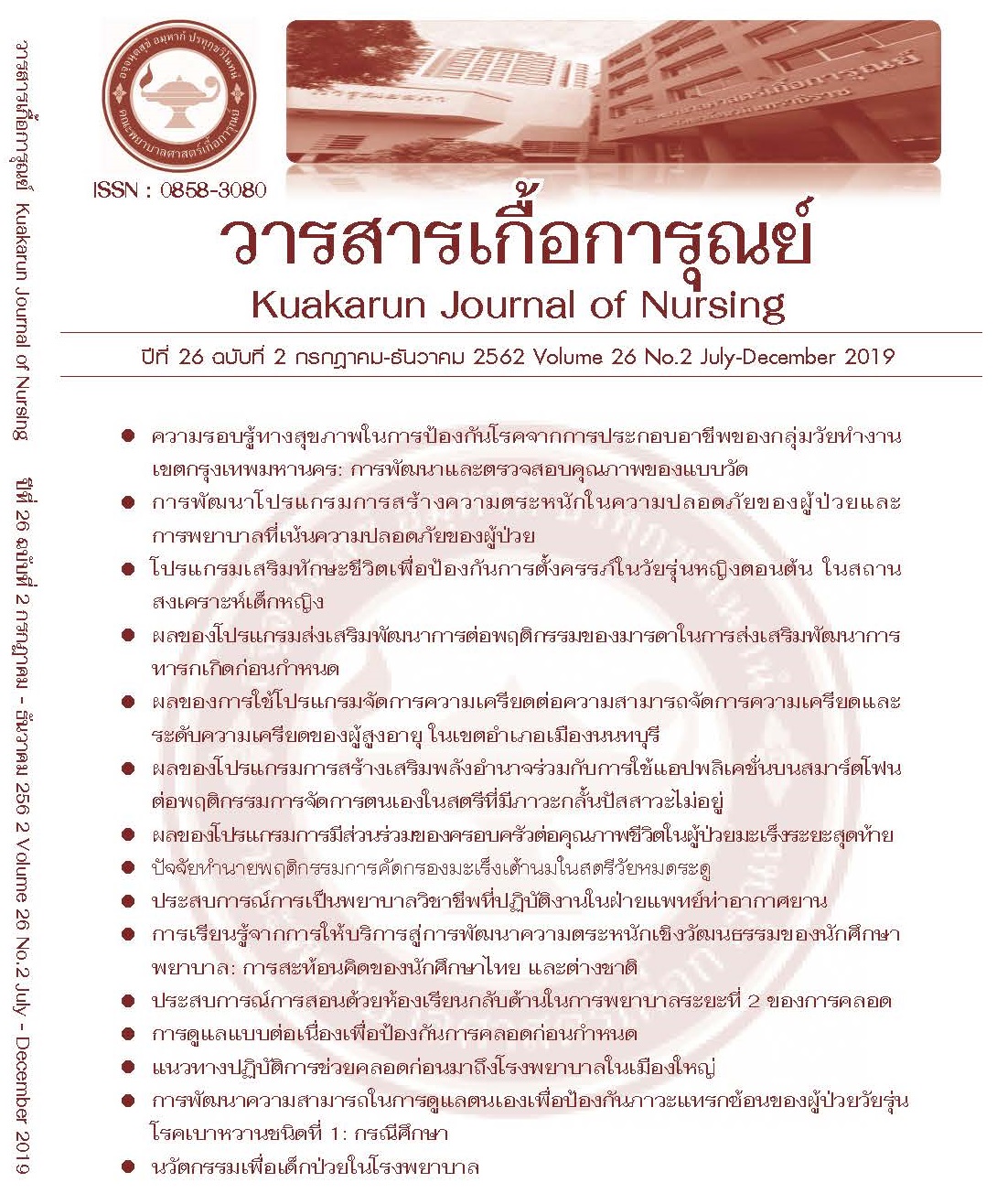การดูแลแบบต่อเนื่องเพื่อป้องกันการคลอดก่อนกำหนด
คำสำคัญ:
การดูแลแบบต่อเนื่อง, การป้องกันระดับปฐมภูมิ, การคลอดก่อนกำหนด, การผดุงครรภ์บทคัดย่อ
การคลอดก่อนกำหนดเป็นปัญหาสุขภาพของทั้งประเทศที่พัฒนาแล้วและกำลังพัฒนา ซึ่งที่ผ่านมาการป้องกันการคลอดก่อนกำหนดจะมุ่งเน้นในสตรีตั้งครรภ์ที่มีปัจจัยเสี่ยงต่อการคลอดก่อนกำหนด อย่างไรก็ตาม อุบัติการณ์การคลอดก่อนกำหนดกลับเพิ่มขึ้นในสตรีตั้งครรภ์กลุ่มที่ไม่มีปัจจัยเสี่ยงต่อการคลอดก่อนกำหนด ซึ่งสตรีตั้งครรภ์กลุ่มนี้เป็นกลุ่มที่มักถูกมองข้ามไป ดังนั้น พยาบาลผดุงครรภ์ควรให้การป้องกันการคลอดก่อนกำหนดระดับปฐมภูมิในสตรีตั้งครรภ์ทุกรายด้วยการดูแลแบบต่อเนื่อง ซึ่งเป็นแนวคิดที่สามารถป้องกันการคลอดก่อนกำหนดได้ โดยเน้นสตรีตั้งครรภ์เป็นศูนย์กลางของการดูแลและ พยาบาลผดุงครรภ์เข้าถึงความต้องการและความคาดหวังทางด้านสุขภาพของสตรีตั้งครรภ์โดยการประเมินองค์รวมแบบต่อเนื่อง อีกทั้งสตรีตั้งครรภ์สามารถเจรจาต่อรองด้านสุขภาพเพื่อตนเองและทารกในครรภ์ได้ ซึ่งแนวคิดการดูแลสุขภาพผู้ป่วยอย่างต่อเนื่องประกอบด้วยการต่อเนื่องของข้อมูล สัมพันธภาพ และการบริหารจัดการ โดยผู้ให้บริการคนเดิมหรือทีมเดิมต่อเนื่องตลอดเวลา แนวคิดดังกล่าวมีความสอดคล้องเชื่อมโยงกับแนวคิดของความเป็นหุ้นส่วนการผดุงครรภ์ซึ่งประกอบด้วย (1) เวลา ความเชื่อใจ และความไว้วางใจ (2) ความเสมอภาค และการแลกเปลี่ยนซึ่งกันและกัน (3) การเจรจาต่อรอง (4) การแบ่งปันพลัง และความรับผิดชอบ (5) การเพิ่มพลังอำนาจ โดยพยาบาลผดุงครรภ์วางแผนให้การดูแลที่มีความยืดหยุ่นและจำเพาะต่อสตรีตั้งครรภ์แต่ละรายเพื่อให้สอดคล้องกับความต้องการที่แตกต่างกัน ซึ่งการที่จะวางแผน การผดุงครรภ์แบบต่อเนื่องได้พยาบาลผดุงครรภ์ต้องใช้เวลาในการสร้างความเชื่อใจ ไว้วางใจ ด้วยความเสมอภาค และมีการแลกเปลี่ยนข้อมูลซึ่งกันและกัน โดยมีการเจรจาต่อรองอย่างเท่าเทียมเพื่อวางแผนการดูแลได้อย่างต่อเนื่องและมีความยืดหยุ่นตามความต้องการด้านสุขภาพของสตรีตั้งครรภ์ พยาบาลผดุงครรภ์สามาถแบ่งปันความรับผิดชอบต่อสุขภาพและเน้นให้สตรีตั้งครรภ์ร่วมรับผิดชอบในการรับการผดุงครรภ์แบบต่อเนื่อง เพื่อสุขภาพของตนเองและทารกในครรภ์ มีการสร้างสัมพันธภาพที่ดีและมีความต่อเนื่องสม่ำเสมอ เพื่อเพิ่มพลังอำนาจให้แก่สตรีตั้งครรภ์ในการสังเกตดูแลตนเองได้ เนื่องจากสตรีตั้งครรภ์เป็นบุคคลที่อยู่กับตนเองและทารกในครรภ์ตลอดเวลาเพื่อป้องกันการคลอดก่อนกำหนดต่อไป
เอกสารอ้างอิง
พีรนันท์ วิศาลสกุลวงษ์. (2560). ปฏิบัติการผดุงครรภ์ร่วมสมัยในการป้องกันการคลอดก่อนกำหนด. ในเด่นนพพร สุดใจ ธิตินันท์ ตัณสถิต และลัลธพร พัฒนาวิจารย์. การดูแลปัญหาที่พบบ่อยทาง สูติกรรมร่วมสมัย. (หน้า 44-54). กรุงเทพฯ: ธนาเพรส.
เอมพร รตินธร. (2559). การดูแลต่อเนื่องหัวใจในการพัฒนาคุณภาพการปฏิบัติการผดุงครรภ์. กรุงเทพฯ: วัฒนาการพิมพ์.
Adu-Bonsaffoh, K., Gyamfi-Bannerman, C., Oppong, S., & Seffah, J. (2019). Determinants and outcomes of preterm births at a tertiary hospital in Ghana. Placenta. 39(1), 62-67. doi:10.1016/j.placenta.2019.01.007
Chawanpaiboon, S., Joshua, P., Vogel, P., Ann-Beth, M., Pisakelumbiganon, P., Max-Petzold, P.,…& Gulmezoglu, A. (2019). Global, regional, and national estimates of levels of preterm birth in 2014: A systematic review and modelling analysis. Lancet Global Health, 7(1), e37-e46. doi:10.1016/S2214-109X(18)30451-0
Cunningham, F., Leveno, K., Bloom, S., Dashe, J., Hoffman, B., Casey, B.,... & Spong, C. (2018). Preterm birth. In Williams Obstetrics. New York, NY: McGraw-Hill Education.
Dahlberg, U., & Aune, I. (2013). The woman's birth experience the effect of interpersonal relationships and continuity of care. Midwifery, 29(4), 407-415.
Delnord, M., & Zeitlin, J. (2019). Epidemiology of late preterm and early term births – An international perspective. Seminars in Fetal and Neonatal Medicine, 24(1), 3-10.
Homer, C., Foureur, M., Allende, T., Pekin, F., Caplice, S., & Catling-Paull, C. (2012). 'It's more than just having a baby' women's experiences of a maternity service for Australian Aboriginal and Torres Strait Islander families. Midwifery, 28(4), e449 - e455.
Homer, C., Leap, N., Brodie, P., & Sandall, J. (2019). Midwifery continuity of care. (2nd ed.). Australia: Elsevier.
Jepsen, I., Mark, E., Foureur, M., Nohr, E. A., & Sorensen, E. E. (2017). A qualitative study of how caseload midwifery is experienced by couples in Denmark. Women and Birth, 30(1), e61 - e69.
Kildea, S., Gao, Y., Hickey, S., Kruske, S., Nelson, C., Blackman, R., . . . Roe, Y. (2019). Reducing preterm birth amongst Aboriginal and Torres Strait Islander babies: A prospective cohort study, Brisbane, Australia. ClinicalMedicine, 12, 43-51.
Rayment-Jones, H., Murrells, T., & Sandall, J. (2015). An investigation of the relationship between the caseload model of midwifery for socially disadvantaged women and childbirth outcomes using routine data--a retrospective, observational study.
Midwifery, 31(4), 409-417.
Reid, R., Haggerty, J., & McKendry, R. (2002). Defusing the confusion: Concepts and measures of continuity of healthcare. Canadian health services research foundation.
Sandall, J., Hatem, M., Devane, D., Soltani, H., & Gates, S. (2009). Discussions of findings from a Cochrane review of midwife-led versus other models of care for childbearing women: continuity, normality and safety. Midwifery, 25(1), 8-13.
Sandall, J., Soltani, H., Gates, S., Shennan, A., & Devane, D. (2016). Midwife‐led continuity models versus other models of care for childbearing women. Cochrane database of systematic reviews, 4, 1-123. doi:10.1002/14651858.CD004667.pub5
WHO. (2016). WHO recommendation on midwife-led continuity of care during pregnancy. Retrieved October 2019 from https://extranet.who.int/rhl/topics/improving-health-system-performance/implementation-strategies/who-recommendation-midwife-led-continuity-care-during-pregnancy
WHO. (2017). Preterm birth: Worlds Health Organization. Retrieved October 2019 from https://www.who.int/mediacentre/factsheets/fs363/en/.
WHO. (2018). Preterm birth. Retrieved October 2019 from https://www.who.int/news-room/fact-sheets/detail/preterm-birth#
Wisanskoonwong, P. (2012). Midwifery primary health care groups during childbearing. Lismore, NSW.: Southern Cross University.
Wisanskoonwong, P., Fahy, K., Hastie, C. (2011). The effectiveness of medical interventions aimed at preventing preterm birth: A literature review. Women and Birth, 24(4), 141-7.















